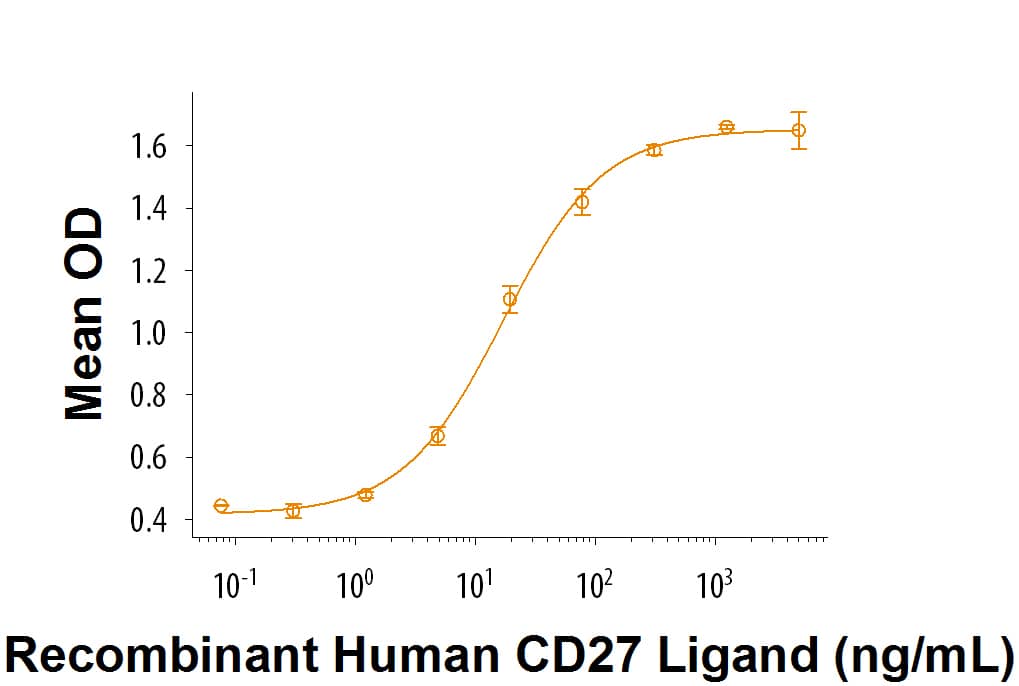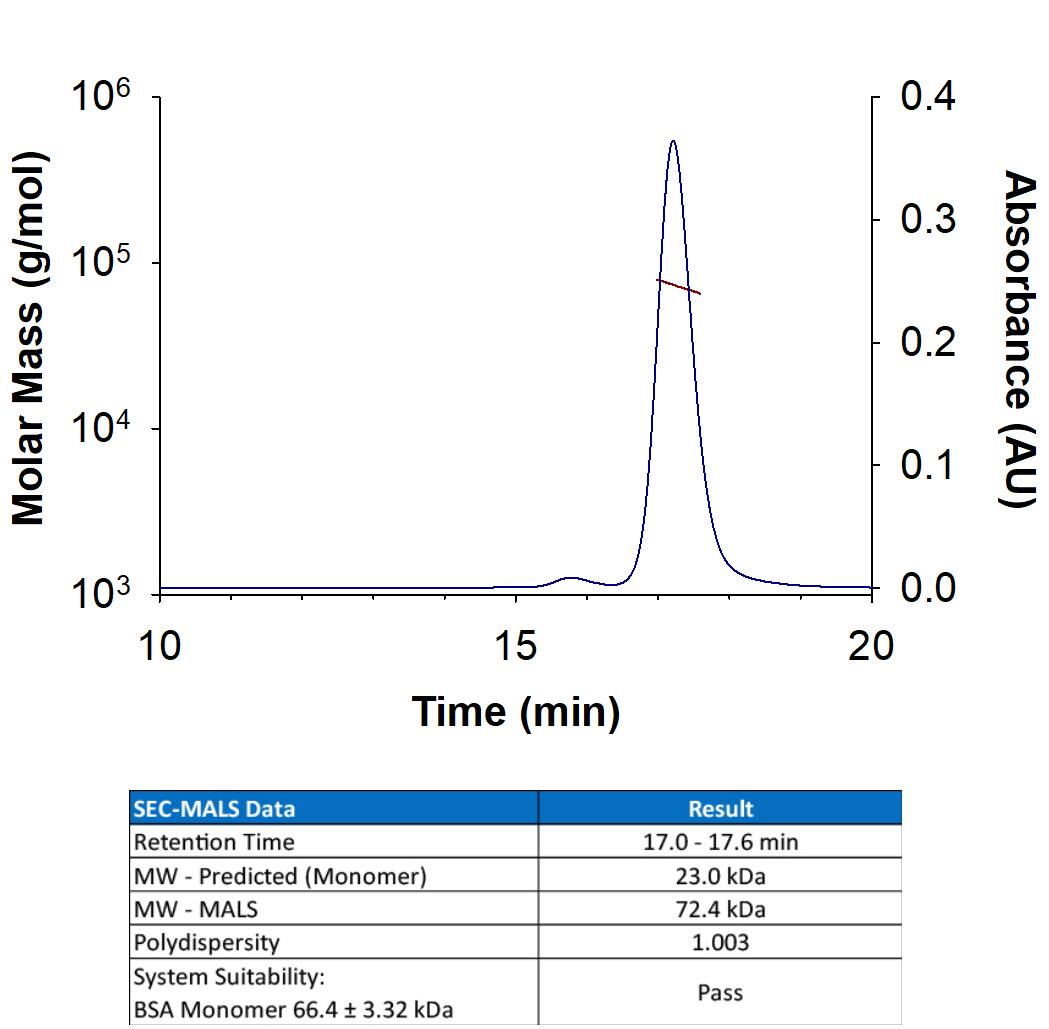Recombinant Human CD27 Ligand/TNFSF7 Protein, CF
R&D Systems, part of Bio-Techne | Catalog # 9328-CL
Analyzed by SEC-MALS

Key Product Details
Source
HEK293
Accession #
Structure / Form
Noncovalently-linked homotrimer
Conjugate
Unconjugated
Applications
Bioactivity
Product Specifications
Source
Human embryonic kidney cell, HEK293-derived human CD27 Ligand/TNFSF7 protein
| HA (YPYDVPDYA) |
GCN4-IZ | GGGSGGGSGGGS | Human CD27 Ligand (Gln39-Pro193) Accession # P32970.2 |
| N-terminus | C-terminus | ||
Purity
>95%, by SDS-PAGE visualized with Silver Staining and quantitative densitometry by Coomassie® Blue Staining.
Endotoxin Level
<0.10 EU per 1 μg of the protein by the LAL method.
N-terminal Sequence Analysis
Tyr
Predicted Molecular Mass
23 kDa
SDS-PAGE
24-32 kDa, reducing conditions
Activity
Measured by its ability to induce IL-8 secretion in HT1080 human fibrosarcoma cells transfected with human CD27.
The ED50 for this effect is 5-25 ng/mL in the presence of Mouse Anti-Hemagglutinin/HA Peptide Monoclonal Antibody (Catalog # MAB060).
The ED50 for this effect is 5-25 ng/mL in the presence of Mouse Anti-Hemagglutinin/HA Peptide Monoclonal Antibody (Catalog # MAB060).
Reviewed Applications
Read 1 review rated 5 using 9328-CL in the following applications:
Scientific Data Images for Recombinant Human CD27 Ligand/TNFSF7 Protein, CF
Recombinant Human CD27 Ligand/TNFSF7 Protein SEC-MALS.
Recombinant Human CD27 Ligand/TNFSF7 (Catalog # 9328-CL) has a molecular weight (MW) of 72.4 kDa as analyzed by SEC-MALS, suggesting that this protein is a homotrimer. MW may differ from predicted MW due to post-translational modifications (PTMs) present (i.e. Glycosylation).Recombinant Human CD27 Ligand/TNFSF7 Protein Bioactivity
Recombinant Human CD27 Ligand/TNFSF7 (Catalog # 9328-CL) induces IL-8 secretion in HT1080 human fibrosarcoma cells transfected with Human CD27. The ED50 for this effect is 5-25 ng/mL.Formulation, Preparation and Storage
9328-CL
| Formulation | Lyophilized from a 0.2 μm filtered solution in PBS. |
| Reconstitution |
Reconstitute at 200 μg/mL in PBS.
|
| Shipping | The product is shipped at ambient temperature. Upon receipt, store it immediately at the temperature recommended below. |
| Stability & Storage | Use a manual defrost freezer and avoid repeated freeze-thaw cycles.
|
Background: CD27 Ligand/TNFSF7
IL-12, TNF alpha, prostaglandin E2 and by CD28 and CD40 co-stimulation (9). Ligation of CD27 on T cells provides co-stimulatory signals and promotes T cell proliferation, antigen-specific CD4+ and CD8+ T cells clonal expansion, effector & memory T-cell differentiation, and effector T-cell survival & T-cell memory formation (10-12). Ligation of CD27 on mouse B cell and NK cells promotes the B- and NK-cell response by supporting B-cell expansion in the germinal center and increasing IFN-gamma levels in NK cells, in turn enhancing NK cytotoxic capability, which can contribute to tumor control (13,14). Overall, CD27/CD70 co-stimulatory system promote T, B and NK cell responses and particularly the CTL response, and is a target in cancer immunotherapy (15).
References
- Bowman MR. et al. J Immunol. (1994) 152:1756.
- Croft, M. (2003) Nature Reviews Immunol. 3:609.
- Tesselaar K. et al. (2003) J. Immunol. 170:33.
- Sanchez PJ. et al. (2007) J. Immunol. 178:1564.
- Lens SM. et al. (1998) Semin. Immunol. 10:491.
- Koenen HJ. et al. (2005) J. Immunol. 174:7573.
- Hintzen RQ. et al. (1994) Int. Immunol. 6:477.
- Borst J. et al. (2005) Curr. Opin. Immunol. 17:275.
- Krause P. et al. (2009) Blood 113:2451.
- Van Gisbergen K. et al. (2011) Immunity 35:97.
- Peperzak V. et al. (2010) J. Immunol. 185:6670.
- Pen JJ. et al. (2013) J. Immunol. 191:1976.
- Shin CA, et al. (2016) Oncotarget 7:46173.
- Takeda K. et al. (2000) J. Immunol. 164:1741.
- Wajant H. (2016) Expert Opin Ther Targets 20:959.
Alternate Names
CD70, TNFSF7
Gene Symbol
CD70
UniProt
Additional CD27 Ligand/TNFSF7 Products
Product Documents for Recombinant Human CD27 Ligand/TNFSF7 Protein, CF
Product Specific Notices for Recombinant Human CD27 Ligand/TNFSF7 Protein, CF
For research use only
